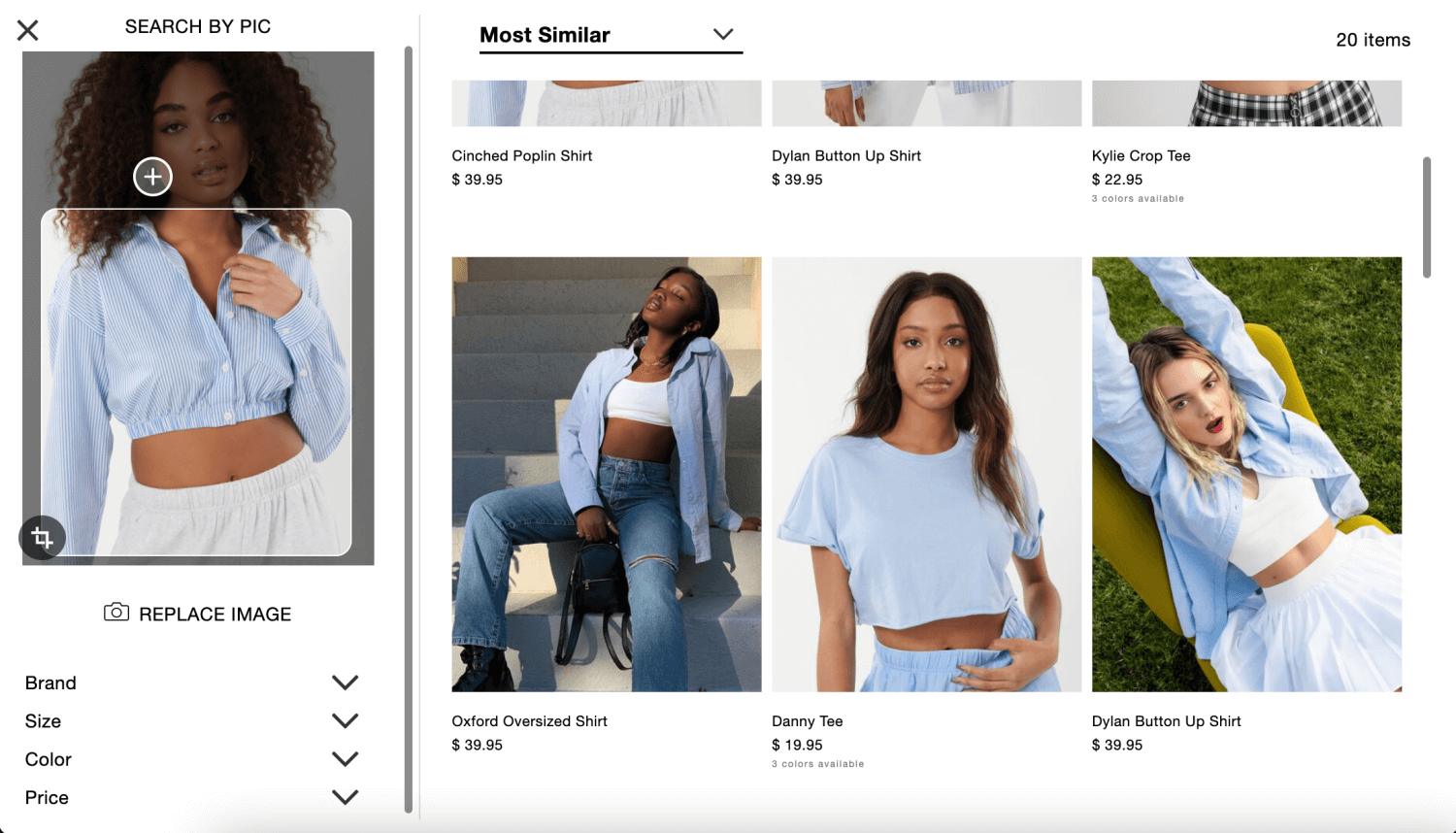Today’s shoppers are more open than ever to leaving their well-loved brands and retailers to try out new products and explore new places and methods to purchase what they desire. Initially, this shift away from loyalty was driven by necessity with the onset of the pandemic. But now, as eCommerce becomes the default way to buy, it’s simply easier and faster to forego loyalties when better services, products, and experiences are within reach.
The upside of this transformation is that more shoppers will be open to trying your brand for the first time, but the obvious question is, how can you keep them from going astray when they’re only a click away from your competitors? We know that a compelling customer experience is what draws shoppers in, but to get there, you need to first ace the gateway to your overall experience: product discovery.

What is Product Discovery for eCommerce?
In eCommerce, product discovery refers to the way your customers explore your inventory on your site and find the most relevant products based on their individual intent, motivations, and preferences.
Contemporary product discovery is not just about the inventory you need to sell (although this is important, too), it’s about understanding your shoppers and showing the right product to the right customer at the right moment. It may not get the same attention as your fulfillment strategy, your packaging, or your customer service, but product discovery is the foundation upon which your entire customer experience rests.
Look at it this way: when shoppers are not able to find the products they’re looking for, your customer experience automatically suffers. The more friction your shoppers face, the longer the journey from product search to purchase, the more likely they are to abandon your website altogether.
The result is an overall negative perception of your brand that’s hard to rebuild and impacts everything from customer acquisition to retention and loyalty. In fact, customers mention positive experiences to an average of nine people; but if they are likely to tell 16 people when they have a negative experience.
5 Best Practices to Optimize Product Discovery for eCommerce
Suffice it to say, focusing on product discovery and ensuring customers get the best experience should be a priority for brands and retailers. To gauge if you’re on the right track when it comes to helping shoppers find their ideal items, check out these product discovery best practices.
1. Make sure your site is easy to search and navigate for every persona
A major part of the product discovery experience is website search and navigation. Search users are the highest-intent of all shoppers, and at least 50% of website visitors use menu navigation to orient themselves, so your search bar and menu must be able to accommodate all types of shoppers.
Here’s a look at what you can do to make your website easy to navigate and enable shoppers to immediately discover products that best fit what they’re hunting for:
Basic tips:
- Give your search bar enough real-estate, so shoppers are more likely to use it, and customize the suggested text based on shopper behavior and location on your site. For example, suggest “New Bakeware” when users are exploring your home and kitchen products.
- Make your drop-down navigation menu more engaging with banners for new arrivals, on-sale items, and best sellers.
Advanced tips:
- Enable your users to find products on your website via image search. This is most beneficial for shoppers who can’t put the product they have in mind into words, and the capability can be added directly within your text search bar.
- Ensure that your on-site search can detect natural language and context so you can surface highly accurate results for when shoppers use synonyms, incorrect spelling, and thematic search terms.
- Promote your products and categories with icon-based or persona-based navigation. For example, use illustrations to indicate different styles of home decor, or name sections in your menu after shopper types (e.g., “The Classic Chic Edit”).
- Provide an additional navigational layer and a deep dive into your catalogue by offering faceted search so users can filter products based on product-specific attributes, like size, color, price, occasion, and more. This enables your shoppers to easily sift through your inventory according to the criteria that matter most to them.

2. Remove all dead-ends
When shoppers hit a dead-end on your website, it not only halts the shopping journey and leaves customers feeling frustrated, but it also prompts them to continue their search on another website. This common issue is highly preventable when you take the following product discovery best practices into account:
Basic tips:
- Take stock of all possible dead-ends and start by ensuring that your error pages always lead to a new path on your website.
- Make sure that filter selections always yield results. If you don’t have a certain color or size in stock, don’t offer the filter.
Advanced tips:
- Optimize out-of-stock situations by suggesting visually similar products or a selection of personalized recommendations.
- Make use of your ‘no results’ page by suggesting products that are related to the item searched.
3. Make visual merchandising relevant, consistent, and engaging
This list of product discovery best practices wouldn’t be complete without touching on your merchandising strategy. Effective online merchandising relies on a robust product tagging system that should be accurate, consistent, and constantly updated. Pairing this strong foundation with smart visual merchandising tactics — including your site layout and the placement and quality of product photos and videos — goes a long way towards improving product discovery.
Basic tips:
- Ensure that your overall website design is clean and uncluttered, even on smaller screens.
- Use high-quality product photos with uniform backgrounds so your products pop.
- Leverage user-generated content to contextualize your products, make them more relatable, and highlight social proof.
Advanced tips:
- Keep your homepage fresh by featuring product collections that automatically get updated when you add new inventory that fits the parameters. For example, you can create product groupings according to popularity, a trendy cut or style, or a special promotion or discount.
- On product detail pages, use image carousels to recommend products that complement the item shoppers are currently viewing. This encourages cross-selling and introduces shoppers to more of your inventory in a hyper-relevant way.
- Personalize your offering. Choose a personalization engine that takes real-time browsing behavior into account, so shoppers find the products that they’ll love most at the right time and in context.
4. Ensure on-site tools are intuitive and accurate to encourage adoption
Shoppers are no strangers to the technological advancements in eCommerce. Many welcome the innovative tools that aim to make shopping more intuitive and convenient for them. But not all eCommerce solutions are easy for shoppers to use.
For investments in digital solutions to be worthwhile, they need to align with your shoppers’ lifestyle, creating similar experiences to what they’re used to from social media or platforms like Netflix. When product discovery solutions like visual search and product recommendations are done well and are easy to engage with, shoppers stick around, seeing as much as a 12% uplift in retention rate compared to other high-intent shoppers who’ve added items to their cart.
When choosing or implementing a product discovery solution, consider the following:
Basic tips:
- Create a comprehensive communication plan when you launch a new feature or capability on your website. This can include an email campaign, a dedicated landing page that explains the new tool, and product tooltips that appear as shoppers browse on your website.
- Make sure you have a strategy in place to evaluate the effectiveness of the tool: this should include customer feedback and usage data, so you can assess and optimize the performance of the new feature.
Advanced tips:
With so many eCommerce solutions on the market, one of the most important product discovery best practices we can share is to choose and implement a solution that goes the extra mile to be engaging for shoppers.
- When implementing camera search, for example, the faster and more accurate results are, the more likely shoppers will enjoy the tool and use it repeatedly
- Consider alternate applications for product discovery technology that may be even more appealing to shoppers: For example, the same mechanism that powers camera search can be applied to your product images, creating new journeys for shoppers to find similar items to any of your products that catch their eye. The more helpful and intuitive the tool, the higher adoption will be.

5. Go the extra mile with personalization
Lastly, like every eCommerce experience, successful product discovery must be personalized. With recent advancements in visual AI, you can now optimize not just for the specific products that appeal to your shoppers but for the design elements that spark their interest. By understanding their taste, you can create individualized product discovery experiences that surface items in your inventory regardless of whether they’re already best-sellers or not.
Basic tips:
- Start with your product recommendation carousels. Shoppers already know to expect product recommendations on virtually any product detail page, making this the ideal opportunity to catch their attention with a selection of items that truly reflects their aesthetic taste.
Advanced tips:
- Apply the same hyper-personalized product discovery experience to your entire website. Ensure that product listing pages and search results load products that each specific shopper is most likely to want to buy first.
- Extend this practice to your omnichannel journey. For example, you can point shoppers towards the items that suit them in-store using your app and push notifications.
Customers Gravitate Towards eCommerce Brands That Prioritize Product Discovery
Shoppers are no longer hesitant to leave a tried and tested brand for a new one promising convenience, accessibility, and value. Creating a memorable, loyalty-enhancing customer experience is difficult without seamless product discovery journeys that help shoppers find what they are looking for down to the minute details. As eCommerce competition continues to grow, brands and retailers need to re-assess how shoppers find products on their websites, address key pain points, and implement product discovery best practices to serve up the items and experiences that will wow their customers.